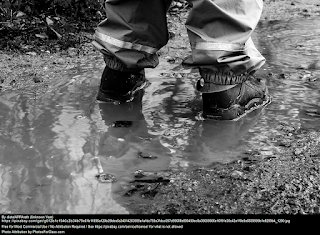Wells_Laura_Free_Choice
Students as Storytellers: Let's begin with a bit of background. My only experience with a storyteller who told stories orally, without a book, was with my grandmother. When we visited, each night should would put me to bed with a story. She told stories of my dad and his siblings growing up. I loved bedtime at grandma's house. t I still remember some of them: my uncle
wearing his rain boots into deep mud and getting stuck-for hours, my dad setting the curtains on fire. I remember her as a wonderful storyteller. It gave me an appreciation not just for storytelling but of the way stories can connect us to our history.Second bit of background, I homeschooled my daughters for seven years. We used a curriculum that followed history. So art, history, literature, music history, some science etc. all radiated from a certain time period. It was cool and exhausting as a teacher/parent. For three of those years, we were in a co-op. At each meeting, three kids had to present a research project or a literature study (like poetry recitation) in an oral presentation with a visual aid. The kids ranged from 5-17-years-old and everyone presented 3 times a year. We taught diction, sequencing, memory cues, listening skills, the importance of color and readability on the visual aids, etc.. If presenters got the giggles, they just started over. Grades were notes from any adult who wasn't related listing 3 great things and 1 area of improvement. My girls are both in college now. They both refer to these presentations and marvel at the presentation skills students in their classes lack. So I wasn't surprised to read about the confidence building, sequencing skills, community connections mentioned in numerous articles this week. My grandmother's storytelling as a bit of my history, my experience watching kids grow confidence when asked to share something that requires practice, and my own love for tales probably all contribute to my desire to let kids tell stories.
I LOVED chapter 10 which detailed various ways librarians and storytellers are
letting kids be the storytellers. I greatly appreciated the detail that Anne Shimojima gave about her fourth grade storytelling unit. I want to replicate it. Kids want to tell stories, but without direction they can be awful at it. My own kids used to make up stories that would go on and on without end because they knew nothing about sequencing. I think using folktales (the easiest and shortest story to tell) rewritten in 2-3 minute versions is brilliant. And taking away the competitiveness of storytelling by teaching both storytelling techniques and listening skills helps.Because I loved chapter 10, I spent a bit of time exploring the web for ideas/programs that helped kids tell stories. There is a program in California called Young Storytellers that runs storytelling courses in elementary schools (kids write scripts with mentors and perform) , middle schools (kids use storytelling to explore to explore goals), high schools (students use storytelling to explore community and exploration). The Young Storyteller's outreach and outcomes are impressive. Here is a link to the outcomes page where I am impressed with the high percentages of teachers who see students who participate in the program increase their confidence, increase class participation, and improve writing skills.
 |
| Screenshot from the website showing the impact of Young Storyteller program in CA |
I also found a a website called The Conversation, a non-profit, fact-based journalism site. There, a professor of literacy shared three ideas she and a co-worker had developed in a curriculum for parents to use during the isolation of the pandemic to teach storytelling. She said storytelling increases confidence (I saw this statement in numerous articles that we read this week), promotes community, and creates a sense of self (Myata, 2020). Her ideas are fun and would work in classrooms too. Of note for me, were the questions she asks in idea number one to help kids think about a story they could tell. They were open ended, not leading, and helpful.
Puppets: I am not a huge puppet fan. I've done a few puppet shows crouched behind a puppet stage. It is hot. And I am not the greatest puppeteer, especially when I can't respond to the audience. I loved Allison Taylor-MyBryde's puppet work. The way she made sound effects and looked at the puppets as real people was mesmerizing. She as mastered the pause, looking at the audience, and she wasn't behind a stage. She made a fascinating argument for how singing and puppetry helps the littlest listener learn language. And she explained how puppets can host or can be blamed for bad singing voices. She was fabulous. I would go to her every week if she was at my library. Sometimes in our library, the preschool class comes. I would like to try puppets with them. With a bit of practice, I MIGHT be able to love Allison's style of puppetry. I certainly want to learn her skill. If you didn't watch the long video, start at about minute 12:30 and watch how she does a version of If You Give a Mouse..., the next puppet example of a Frog and Toad story was amazing too and funny, like all Frog and Toad stories. She used oven mitts for Frog and Toad, which was brilliant.
Reading for the week: None of the reading this week struck a cord for me as far as personal storytelling, but I did gain a diverse cultural education. Since I sometimes have students from various countries ask for stories from their country, this is helpful. Maybe I should learn some of these so I can share and make those student feel seen. I can imagine using some of these stories as potential for kids to tell (especially the silly parables or crazy tall tale episodes). I learned some parables from Islamic cultures, some myths from China, learned mermaid myths from various countries, and cemented my knowledge of classic American tall tale heroes.

.png)






Hi Laura,
ReplyDeleteI really your blog this week and thought you brought up a lot of great points. We have discussed the many benefits kids get out of listening to storytelling, but there are also a lot of benefits to learning how to present. It sounds like you had a very well thought out homeschool curriculum that may have made learning more fun and interesting than some of the more widespread, public-school curriculums. I had similar experiences with how public schools do not place much emphasis and presenting as well as how important those skills can be. When I was in the Marine Corps a large portion of my job was presenting information to large audiences of people that all outranked me by a lot and having to answer questions if my presentation did not cover everything. For most people with my job, it was a trial by fire situation until we developed those sills. It is also something we tried to work through with our junior Marines so they could develop presentation skills and confidence before they had to do it for real. We had the same experience as your daughters’ when it came to working with eighteen-year old’s fresh out of high school that could not talk about anything in front of an audience. Thank you for sharing your thoughts this week, I enjoyed reading through your blog.